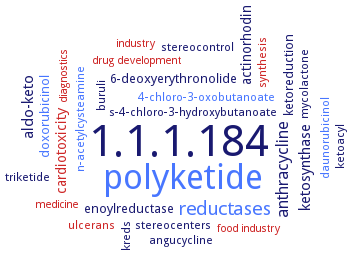1.1.1.184: carbonyl reductase (NADPH)
This is an abbreviated version!
For detailed information about carbonyl reductase (NADPH), go to the full flat file.

Word Map on EC 1.1.1.184 
-
1.1.1.184
-
polyketide
-
reductases
-
anthracycline
-
aldo-keto
-
ketosynthase
-
cardiotoxicity
-
actinorhodin
-
6-deoxyerythronolide
-
enoylreductase
-
doxorubicinol
-
ketoreduction
-
n-acetylcysteamine
-
triketide
-
mycolactone
-
buruli
-
synthesis
-
stereocenters
-
4-chloro-3-oxobutanoate
-
angucycline
-
kreds
-
ulcerans
-
s-4-chloro-3-hydroxybutanoate
-
ketoacyl
-
stereocontrol
-
daunorubicinol
-
medicine
-
diagnostics
-
industry
-
drug development
-
food industry
- 1.1.1.184
- polyketide
- reductases
-
anthracycline
-
aldo-keto
-
ketosynthase
- cardiotoxicity
-
actinorhodin
-
6-deoxyerythronolide
-
enoylreductase
- doxorubicinol
-
ketoreduction
- n-acetylcysteamine
-
triketide
-
mycolactone
-
buruli
- synthesis
-
stereocenters
- 4-chloro-3-oxobutanoate
-
angucycline
-
kreds
- ulcerans
-
s-4-chloro-3-hydroxybutanoate
-
ketoacyl
-
stereocontrol
- daunorubicinol
- medicine
- diagnostics
- industry
- drug development
- food industry
Reaction
Synonyms
(R) specific carbonyl reductase, (S)-specific carbonyl reductase, 15-hydroxyprostaglandin dehydrogenase [NADP+], 2,5-diketo-D-gluconic acid reductase, Adipocyte P27 protein, aldehyde reductase 1, aldehyde reductase I, aldo-keto reductase, ALR3, AP27, carbonyl reductase, carbonyl reductase (NADPH), carbonyl reductase 1, carbonyl reductase 3, carbonyl reductase S1, CBR, CBR 1, CBR 3, CBR1, CBR3, CHCR, CHCR1, CHCR2, CHCR3, CR, CR125, crc1, CSCR1, Gox0644, Gox1615, hCBR1, ketoreductase, KLCR1, KR, LCR, LOC415661, LOC610164, microsomal carbonyl reductase, More, NADP+-dependent ADH, NADPH-carbonyl reductase, NADPH-dependent carbonyl reductase, NADPH-dependent carbonyl reductase S1, NCCR, nonspecific NADPH-dependent carbonyl reductase, peroxisomal-type carbonyl reductase, PHCR, prostaglandin 9-ketoreductase, Prostaglandin-E2 9-reductase, PTCR, R-specific carbonyl reductase, reductase S1, reductase, carbonyl, RLCR, SCR, SCR9, SDR21C1, secondary-alcohol: NADP+-oxidoreductase, short-chain (S)-1-phenyl-1,2-ethanediol dehydrogenase, short-chain carbonyl reductase, sniffer, SRED, SSCR, SyS1, tetrameric carbonyl reductase, Tm1743, Tm_1743, xenobiotic carbonyl reductase, xenobiotic ketone reductase, YGL039w1, YGL039w2, YtbE, YueD


 results (
results ( results (
results ( top
top





